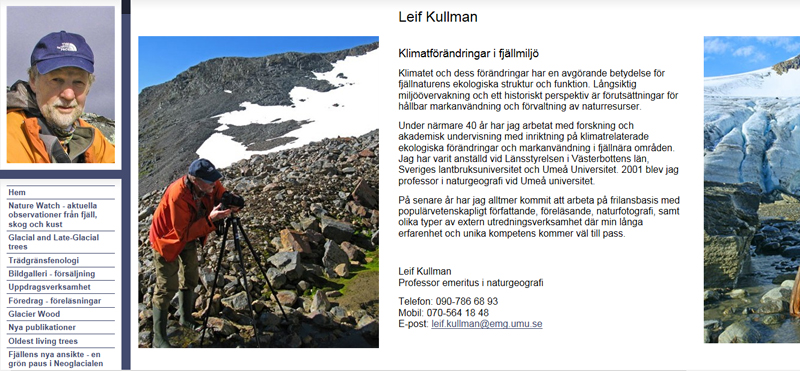
http://www.kullmantreeline.com/
Leif Kullman, Sveriges främste expert på förändringar i vår fjällvärld. Det har skett förändringar i vår fjällvärld under 2000-talet. Det har blivit kallare, växtrikedomen har minskat efter att tidigare ha ökat under senare delen av 1900-talet. De växtarter som minskat är de arter som tidigare hittat växtplatser högre upp på fjällsluttningarna. Detta visar på växternas förmåga att anpassa sig till förändringar. Största betydelsen är kanske inte medeltemperaturen utan snölegorna som ligger kvar länge på försommaren.
Se abstractet/sammanfattningen till Leif Kullmans artikel ”Recent cooling and dynamic responses of alpine summit floras in the southern Swedish Scandes”
Changes in plant species richness on alpine summits in the southern Swedish Scandes were analyzed between 2004/2006 and 2012. This period experienced consistent summer and winter cooling and finalized with a cold and snow rich summer 2012. Re-surveys of these summits had previously documented substantial increases in species numbers in concordance with climate warming since the mid-20th century. Over the present study period, species richness decreased by 25–46%. The majority of lost species were those that had advanced upslope during the previous warm episode. Cooling since the mid 2000s and particularly the unusually short and snow-rich growth period in 2012 caused a floristic retrogression. Taken together with extensive upshifts of many species during previous relative warm decades, recent downshifts highlight the large capability of certain alpine species to track their ecological niches as climate changes. The pivotal importance of unusually late-lying snow in 2012, suggests that snow cover phenology exerts a more direct effect on the composition of the alpine flora than ambient temperatures. Dynamic modeling of future ecological landscape evolution needs to consider episodes of the kind reported here.
http://onlinelibrary.wiley.com/doi/10.1111/j.1756-1051.2013.00229.x/abstract